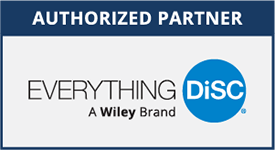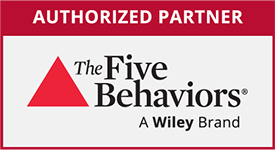Ivy shares about how DiSC uses a common language to unify your workforce.
Improve workplace culture with personalized insights that inspire behavior change.
Everything DiSC® connects people on a human level to deliver “A-ha!” moments that transform workplaces from talented individuals into collaborative, thriving cultures, Teams, Managers and Leaders.
Powered by Wiley: Everything DiSC® is fueled by over 40+ years of assessment-backed expertise and 200+ years of publishing excellence.
What is DiSC®?
Everything DiSC® is a personal development learning experience that measures an individual’s preferences and tendencies based on the DiSC® model. This simple yet powerful model describes four basic styles: D, i, S, and C, and serves as the foundation for the Everything DiSC Application Suite. Participants receive personalized insights that deepen their understanding of self and others, making workplace interactions more enjoyable and effective. The result is a more engaged and collaborative workforce that can spark meaningful culture improvement in your organization.
Dominance Style – Direct and Decisive
The D behavioral style has strong-willed, strong-minded people who like accepting challenges, taking action; and getting immediate results.
Influence Style – Optimistic and Outgoing
The I behavioral style has “people people” who like participating on teams, sharing ideas, energizing and entertaining others.
Steadiness Style – Sympathetic and Cooperative
The S behavioral style has helpful people who like working behind the scenes, performing in consistent and predictable ways, and being good listeners.
Conscientiousness Style – Concerned and Correct
The C behavioral style has sticklers for quality and like planning ahead, employing systematic approaches, and checking and re-checking for accuracy.
We are always a combination of all 4 behavioral styles however most of us spend more time using our top 2 favorites thus creating our own unique pattern. Each behavioral style views the world in a different way with its own set of priorities, preferences and goals. By taking time to discover our individual style preference we open a window to explore and enhance our own self awareness. This base line allows us to turn our attention outward and begin exploring the behavior of others. Understanding the needs of others in the workplace leads to the following:
- better communication
- improved working relationships
- reduced conflict
- enhanced teamwork
- more adaptive management and leadership skills
- greater productivity and results by working effectively together
Adaptive Testing
This allows an assessment to change depending on a respondent’s previous answers. This is useful in cases where the results of a standard assessment are inconclusive. In these instances, the Everything DiSC® assessment will ask the respondent additional questions to reduce ambiguity in their results. Adaptive testing is the latest improvement to increase the accuracy of the Everything DiSC® assessment and make the feedback more personalized and relevant for users.
How is this assessment better than the 79-item assessment?
This change was initiated to better align with the standards established by the psychological assessment community. Adaptive Testing produces more precise results, which in turn provides a better experience for the user.
The Adaptive Testing assessment data is currently being used in all Everything DiSC profiles to provide even more precise dot placement on a participant’s Everything DiSC map.
The biggest benefit of Adaptive Testing is a more precise measurement—increased personalization based on this greater precision and accuracy leads to a more accurate profile. Respondents will see all of their priorities reflected in their DiSC feedback, even if they prioritize things that aren’t usual for their styles. For example, someone whose assessment results indicate a high-i style will be able to see that they also prioritize Accuracy (typically a C priority.) Using AT, respondents can have three, four, or even five priorities. This is a level of precision we simply couldn’t capture before. And it’s this precision in measurement and increased personalization in reporting that equals a better participant experience. Or, as one high-i who prioritizes Accuracy said during beta testing, “I feel validated.”
All Everything DiSC profiles use Adaptive Testing. Here’s more detail on the benefits:
- It’s more precise: Wiley improved the measurement technology. The AT measurement is more aligned with the standards of the psychological community, it has been thoroughly beta tested, and the precision of the measurement has increased while assessment-taking time has decreased.
- It’s been thoroughly proven: The most extensive validation research has been conducted in Wiley history. Two independent agencies were hired to perform multiple rounds of analysis focused on construct validity. Two of the most well-respected academic assessments in the psychological community were used to establish construct validity of the Everything DiSC AT assessment: NEO PI-RTM and 16PF®. The agencies also compared the construct validity of the Everything DiSC AT assessment to the Everything DiSC 79- item assessment and the DiSC Classic 28-item assessment.
How many questions are there?
It depends! AT starts with a pool of questions. As a person responds, EPIC will adapt the questions given to the respondent based on his or her answers to previous questions. So the number of questions will be different for each person based on how they respond.
How long does it take to complete?
15 to 20 minutes
Here’s what has been gained:
- The AT measurement is 32% more accurate than DiSC Classic. It provides a superior user experience: Increased personalization results in a more satisfying participant experience.
- In addition, beta testers were asked to rate the fit of their dot placement, shading, and personalized narrative feedback in their Everything DiSC Workplace (the first Everything DiSC Assessment to receive Adaptive Testing) Adaptive Testing profiles. Again, over 90% of respondents rated the fit as “good” to “excellent”.
What’s the bottom line?
- It’s more precise: with the improved the measurement technology
- It’s been thoroughly proven: the most extensive validation research in Wiley history
- It provides a superior user experience: increased personalization results in a more satisfying participant experience
DiSC® Theory
Based on William Moulton Marston’s identifications of ‘primary emotions’ in his 1928 book, Emotions of Normal People, DiSC® is defined by a set of behavioral responses, which today we know as Dominance (D), Influence (i), Steadiness (S), and Conscientiousness (C).
Initially these styles were established through an understanding of the two primary axes at play in DiSC theory. The Vertical axis represents a scale between Active and Fast Paced styles (assertive, bold, dynamic personalities) on the Northern end of the scale and Reflective or more Moderately Paced styles (calm, methodical, careful individuals) on the Southern end of the scale. And, on the horizontal scale, generally more Questioning or Logic Focused styles (objective, skeptical, challenging behaviors) on the Western end versus more Accepting or People-Focused (initially exhibiting more empathizing, agreeable and receptive behaviors) on the Eastern end of this continuum. Using these two axes, we can form the four quadrants of the DiSC model:
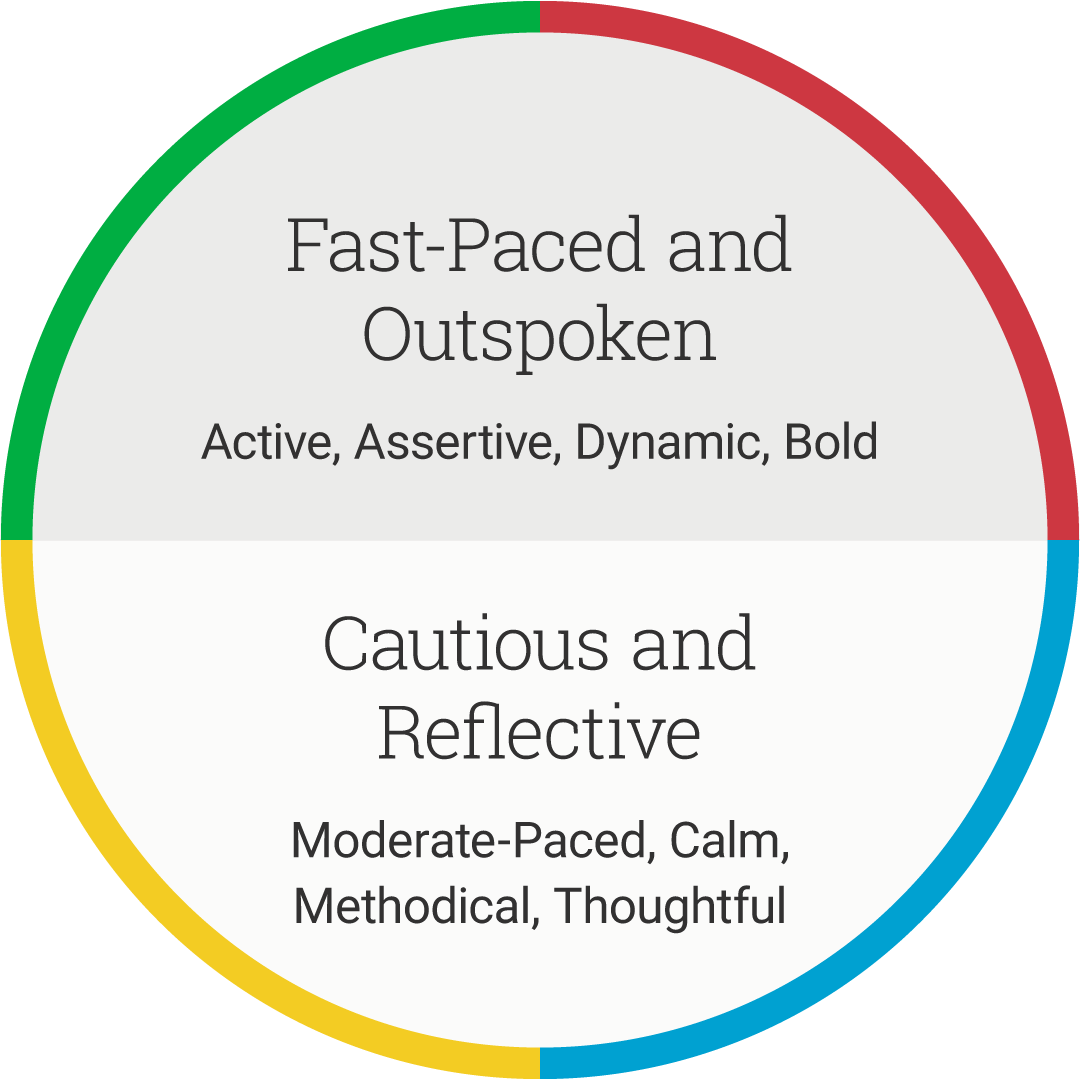
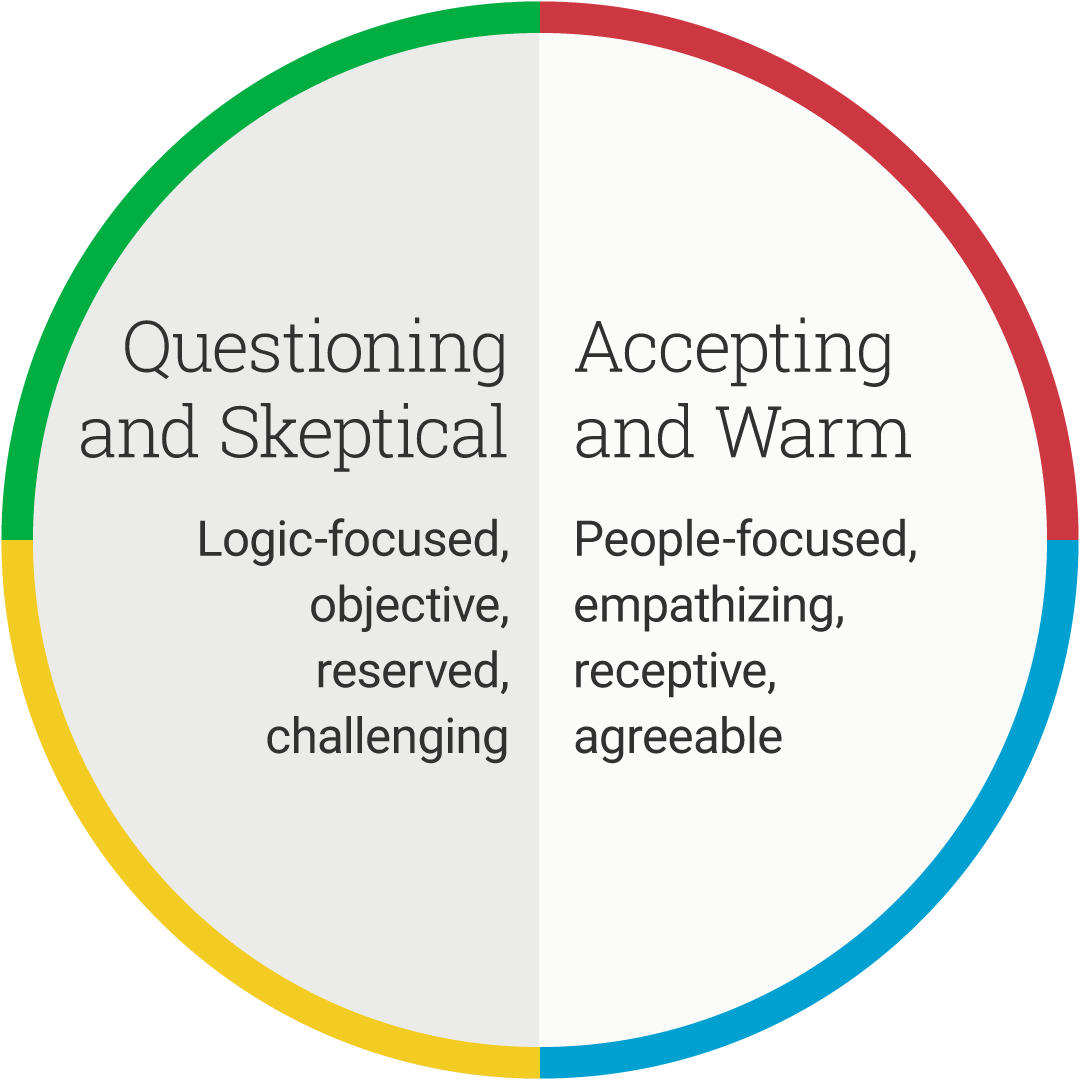
The D (Dominance) style is active and questioning. This describes people who are direct, forceful, and outspoken with their opinions.
The i (influence) style is active and accepting. This describes people who are sociable, outgoing, enthusiastic, and lively.
The S (Steadiness) style is thoughtful and accepting. This describes people who are gentle, accommodating, and patient with others’ mistakes.
The C (Conscientiousness) style is thoughtful and questioning. This describes people who are analytical, reserved, and precise.
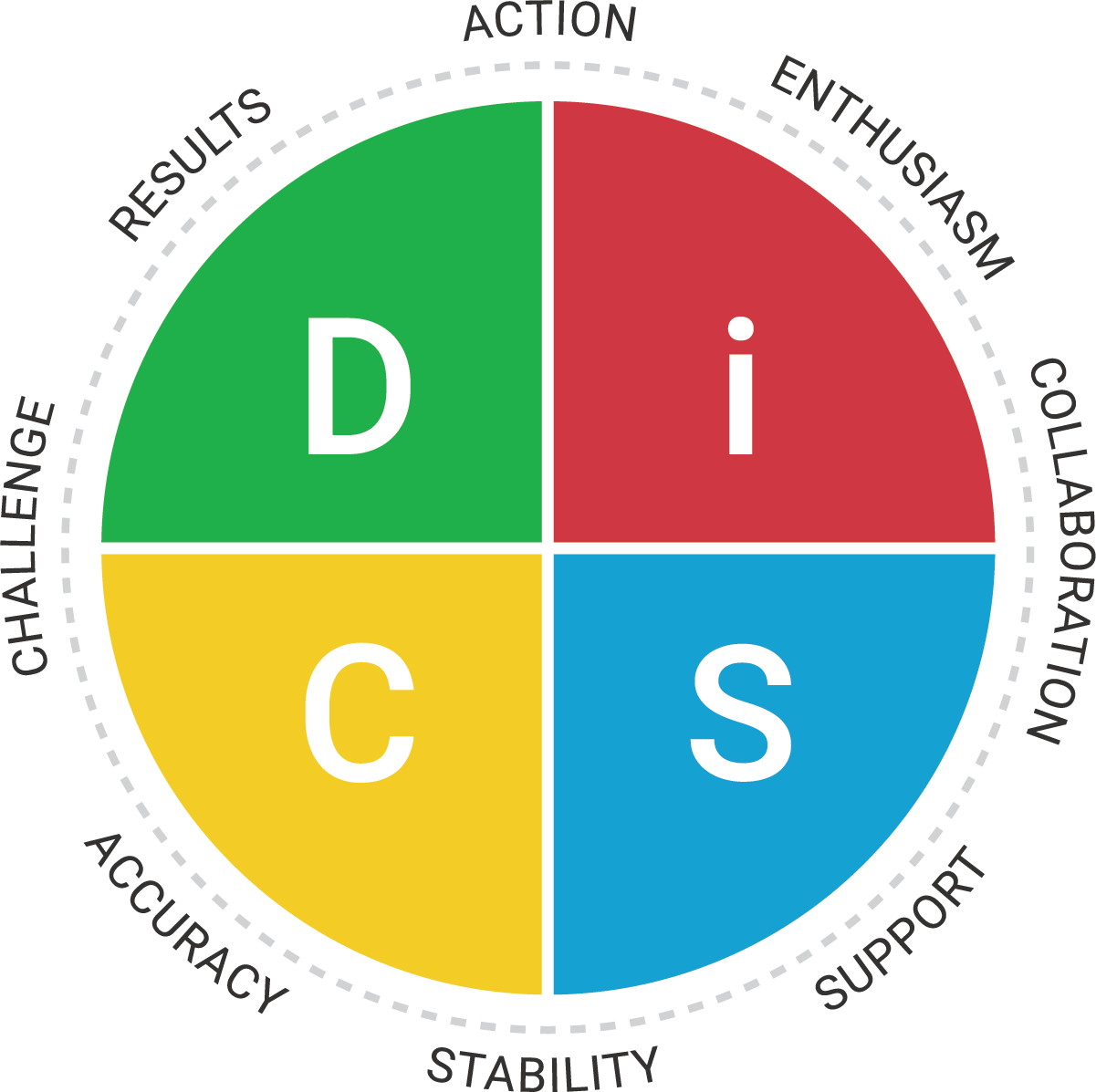
Research indicates that most people tend towards one or two more prevalent behaviors as a primary and secondary style, however we are each always a combination of all four styles and often have to exert more energy to access our less natural preferences when the circumstance calls for it. Additionally, there is no one style (or style combination) that is any better than another. As a matter of fact, we aspire to be able to healthily access all of the styles and priorities around the Circumplex, when necessary, in order to achieve more effective and sustainable relationships with others. In this way, we encourage individuals to stretch and move around or across the Circumplex in order to adapt their behaviors and meet the needs of the environment or the individuals with whom they are working.
Though over the years, there have been numerous assessments and profiles created to evaluate these sorts of personality and behavioral attributes, Wiley’s Everything DiSC® assessment is not only based on the original model, but is also one of the most highly researched models and most reliable and valid tools in the psychometric market today. Everything DiSC integrates results from sophisticated adaptive testing (using advanced algorithms to quickly analyze responses and offer personalized feedback) in order to place the participant’s ‘dot’ on the Circumplex model with remarkable precision as illustrated here. This sort of technology is currently not used in any other DiSC measurement tool on the market.
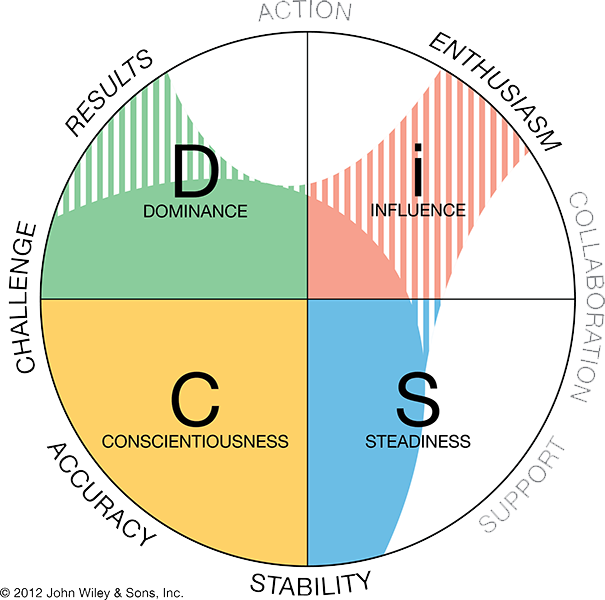
Offering multiple levels of interpretation, Wiley’s most sophisticated model represents the individual participant’s D – I – S – C behavioral style or preference, it lends insight into the inclination of the participant toward that style (strongly/moderately/mildly) based on the dot’s placement and proximity to the outer edge of the circle, and it even identifies the three to five nuanced priorities most often shaping the experience of the participant as indicated by shading around the dot placement in relation to the eight priorities on the outer edge of the Circumplex.
Everything DiSC goes on to offer rich narrative allowing the participants to dive more deeply into learning about themselves, contextual learning so that the individual may gain insight into the experience of other styles (for maximum understanding of those with whom we work), and then identifies personalized prescriptive strategies for the participant in order to facilitate more effective and sustainable relationships.

